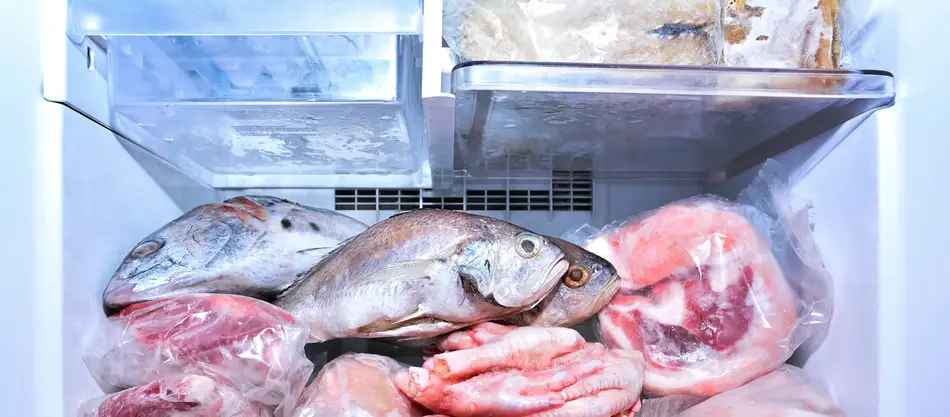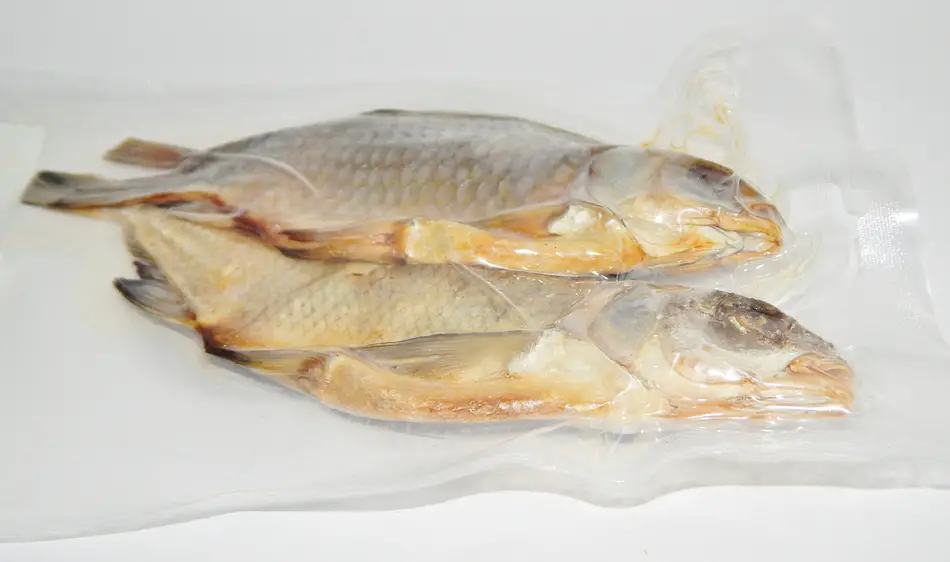
Freezing fish is a common way to preserve your catch and have it taste as fresh as possible. This is generally done after you’ve cleaned and gutted the fish. But there’ll be a time where you didn’t clean or gut your fish, and now you’re considering freezing your ungutted fish.
So this begs the question, can you freeze an ungutted fish?
Yes, you can freeze an ungutted fish for 2 – 6 months without any issues. The exact number of months depends on the type of fish, your freezer type, and how you prepared the fish to be frozen. Fatty fish can be frozen for up to 3 months, whereas lean fish can be frozen for up to 6 months.
Before you start freezing your ungutted fish, there’re some things you can do to keep your fish lasting and tasting as fresh as possible in the freezer.
How To Prepare An Ungutted Fish For The Freezer?
Before you decide to put your ungutted fish in the freezer, there’re a few steps you should take to keep your fish as fresh as possible.
- Bleed The Fish
- Wash & Dry The Fish
- Leave the Scales On The Fish
Bleed The Fish

The first step to freezing your ungutted fish starts when you land it. And this step is to bleed out the fish.
Fish blood is what gives you that “fishy” taste and odour in the meat. And that “fishiness” can worsen over time, especially after it thaws out from being frozen.
Why Does The Fishiness Smell And Odour Worsen After Thawing?
When you freeze a fish that has not been bleed out, the water content in the blood also freezes. When you thaw out the fish, the blood’s water content will get pulled out from the blood.
This intensifies the minerals in the fish’s blood, giving you that fishy taste and smell.
How To Properly Bleed A Fish?
Knowing how to properly bleed a fish will give you better-tasting fish that lasts longer. For the best results, you should do this as soon as you land the fish.
Waiting too long after the fish dies will make bleeding it harder. This is because the blood will start solidifying.
Bleeding out a fish can be done by doing the following:
- Knocking out the fish
- Cut into its gills,
- Place the fish’s head into the water. This will prevent the blood from clotting in the gills.
- Push out the blood from the fish by running your hand along the body of the fish.
Wash & Dry The Fish
The next step is to wash off the fish’s outer layer of slime.
The slimy layer is the fish’s protective coating made from mucus and bacteria. When freezing fish, we want to get the fish as clean as possible.
To wash off the fish’s slime, simply rinse it under cold or warm fresh water and rub the slime off with your hands.
Once the slime is off, dry the fish by using a clean cotton cloth or paper towels.
Leave The Scales On The Fish
Lastly, I would recommend that you keep the scales on the fish.
The scales act as a barrier to protect the fish’s skin from the air. Doing this will keep the skin as fresh as possible.
The more air that makes contact with the fish’s skin will cause the skin to dry out. The scales can be removed later when you decide to clean and cook your fish.
How To Properly Freeze An Ungutted Fish
Make Sure The Fish Is Dry Again
After you’ve washed and dried your fish, what can happen afterwards, is moisture from the fish can be pulled out from the skin again.
So you want to make sure you give your fish another pat down with the paper towel to make sure it’s completely dry again.
Wrap The Fish
To store your ungutted fish in the freezer, you need to eliminate as much air as possible from making contact with the fish.
Air will increase the fish’s chances of getting freezer burn. So you want to do your best to eliminate as much air as possible.
Wrapping with Plastic Wrap
A quick and easy way to wrap your fish is to simply wrap it using plastic wrap.
Plastic wrap will do a good job keeping the air out from the fish, but unfortunately, it will not remove ALL the air.
This means you should eventually eat the fish sooner than later if you want to have a fresh-tasting fish.
If I’m wrapping my fish in a plastic wrap, I tend to put the wrapped fish inside a plastic bag before putting it in the freezer. I do this to protect the fish’s delicate skin from contacting other frozen foods. And to keep any moisture or smells within the bag.
Vacuum Sealing

Suppose you’re planning on freezing your fish for an extended period-of-time. In that case, the best way to ensure that your fish lasts and tastes as fresh as possible is to vacuum-seal your fish.
Vacuum sealing is the only way to remove all the air from the packaging, which is the secret to long-lasting fresh fish. But how much longer can your fish last when vacuum sealed?
How does over a year sound to you?
That’s right, you can store your fish well over a year when they are properly vacuum sealed without losing that freshness.
Check out my favourite starter vacuum sealer that won’t break the bank and will get the job done nicely.
How Does Your Freezer Type Affect Storing Ungutted Fish
When storing an ungutted fish in a freezer, you’ll want your freeze to hold a temperature around 0ºF (-17ºC) or lower to ensure your fish reminds as fresh as possible.
There’re two types of freezers that you need to be aware of because how they operate will affect how long you should keep your fish in the freezer.
Conventional Freezer
This type of freezer will hold a steady temperature. The moisture in the air will condense on the wall of the freezer, causing it to freeze.
This will slowly create a layer of ice to build up.
Because these freezers hold a steady temperature, they are generally considered better when storing fish for longer.
Frost Free Freezer
This type of freezer works by holding a temperature for a certain period. Afterwards, it slowly increases its temperature to ensure there is no frost build up in the freezer.
No frost build-up is excellent when it comes to keeping your freezer clean and tidy. But it’s not great for storing food for long periods.
For the freezer to not have a frost build-up, the freezer temperature has to go above 32ºF (0ºC). If you don’t believe this is a big deal and have this type of freezer. I recommend you fill up an ice cube tray with water and put it in the freezer. Over time, you will see the ice cubes get smaller and smaller.
This is because the temperature rises and evaporates a thin layer of ice. But how does this affect the food that you store in these types of freezers?
The outermost layer of the food is experiencing a similar situation. As the temperature rises and drops, your food’s outer layer is being warmed up and frozen again and on repeat.
Because of this, when you store fish in these freezers, they tend to not last as long.
Exactly how many months do these freezers reduce how long a fish can be frozen for is hard to say. It depends on the type and size of the fish.
Based on personal experience with both types of freezers, I would say that it would reduce the duration by about a month.
How To Thaw A Frozen Ungutted Fish
Typically when you thaw a frozen fish, you gradually let it warm up to room temperature. You DON’T want to do this when the fish has not been gutted.
If you let your ungutted fish warm up to room temperature, what will happen is that the meat will warm up first. But the internal organs will be cold or even partially frozen. This temperature difference between the meat and organs will create condensation in the fish’s belly. And it will pull out some of the water content from the organs.
Personally, I don’t like the idea of “gut water” in my fish.
So what should you do?
I start with gutting the fish when it’s partially frozen. You want the outside to be somewhat soft but really cold. The texture should feel slightly firmer than the palm of your hand.
At this stage, the fish should be soft enough where you can start cutting into it but cold enough where it feels like you`re hacking at the fish. As you handle the fish, the meat will warm up.
You can pull the organs out from the fish when they`re still frozen. This leaves very little to no “gut water” in the fish’s belly.
After the guts have been removed, you can remove the fish’s scales and rinse under warm water. Pat it dry with a paper towel or cloth, and it should be at or pretty close to room temperature at this point and ready to hit the pan.
Health Risks When Freezing Ungutted Fish

When you freeze fish, the process of bacteria growing is halted or severely slowed down. This is why you can freeze food, and it can last for a long time.
As long as you properly handled your fish as soon as you caught it, properly prepared it to be frozen, and thawed it out properly, then you should have no issues.
The concern is making sure that if you plan on freezing your fish, it is done right away. You don’t want to have your fish sitting around for two days in the fridge or on ice just to freeze it afterwards.
Not only will it ruin the flavour of the fish, but it gives time for bacteria to grow. If you let too much time pass after a fish dies before freezing about 2-3 days, you run the risk of potentially getting food poisoning.
There’re two different types of food poisoning that you can get from eating spoiled fish.
- Scombroid
- Ciguatera
Both these types of food poisoning can have similar symptoms, such as:
- Diarrhea,
- Headaches,
- Cramping,
- Numbness,
- Redness in the Face.
Fortunately, for most cases, these symptoms will be gone within a day or so. But you’re not going to have a fun time. It can take up to 30 mins to a few hours after eating a spoiled fish before you start feeling the symptoms.
You can try taking some over the counter medication like Benadryl to get some relief. But if you feel like you got food poisoning, it would be best to contact a doctor right away.
The best way to avoid getting sick is to just clean and gut your fish as soon as you can.
Happy Fishing and Tight Lines!
